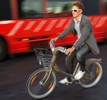A perfect moment. Paul and I rode down Boulevard Raspail to pick up our children from our friend’s house on bikes. It was as if instead of Paris, we were bike riding in Amsterdam. The streets were empty, bike trails throughout. When did Paris become so bike friendly? This is the latest craze sweeping Paris, and coincidentally, good for the environment, the Vélib.

Beginning last July 15, thousands of bicycles became available in Paris at hundreds of self-service docking stations installed around the city by J. C. Decaux, an outdoor advertising company. Anyone, even fresh-off-the-plane Americans (of course, almost anyone who has a credit card with a chip or a ‘puce’), can stroll over, swipe a credit card and ride away on a sturdy, well-maintained three-speed bike, a “vélo” in French. Access to the bikes is available all of the time; it’s liberating, as in “liberté,” so the “Vélib” was born.
At twelve weeks after the introduction of the Vélib, 15,000 bikes had been put into service at more than 1,000 stations. In that time Vélibiens (or Vélibeurs or perhaps Vélibistes) have checked out bicycles almost six million times and ridden them an estimated 7.5 million miles.
The Vélib system is simple. You swipe a credit card in a kiosk that is located beside a row of parked bikes and purchase a one-day, one-week or one-year subscription. There are two of them near our apartment. (The system also takes a 150-euro deposit authorization to ensure the bike’s safe return.) The machine prints out a card with your code number and you enter a personal password. You tap in this code and password to unlock a bike and ride off.
Look at the guide map and look for a nearest Vélib station before you take off. I once spent extra few minutes riding around a tea salon looking for a station since I had not done my homework and the neighborhood was not so familiar. When you have reached your destination, and to the nearest Vélib station, click your bike into an empty dock, watch a light change from yellow to green to acknowledge that you’ve returned your bike, and you’re done. The first half-hour is free, after that the cost is 1 euro, or about $1.45, for the second half-hour, 2 euros for the third half-hour and 4 euros for each half hour after that.
The Métro stops running around 1 a.m., but the Vélib kiosks are open all night, solving one of the city’s most frustrating transportation problems.
If out of curiosity you want to see how much you were charged, or just how far you’ve gone, tap in your code on the Vélib Web site, www.velib.paris.fr, and your Parisian biking history appears. There’s a catch, of course. When I first tried to check out a Vélib, my erudite husband asked, “Does your credit card have a puce?”
I knew what that meant. I had been to the Marché aux Puces. My card had no fleas. In Europe, however, a tiny computer chip, a puce, that contains security data about the card holder is embedded in the plastic and triggers the kiosk’s release mechanism. Only some American cards have this smart chip, which is usually visible as a small gold or silver circuit board on the face of the card. Without a puce, I might not have been able to rent a Vélib.
The French have embraced communal bike ownership, according to my informal survey of my fellow Vélibiens, as have other Europeans. A culture of Vélibistes is emerging. The camaraderie — a French word that seems to have been invented in anticipation of this new cult — among the riders is entrancing. Riders advise one another on where to find the nearest Vélib docking station, where to park if one is full, and how to find the best routes around the city. When they speak of Vélibs, Parisians smile, even those like a waiter who admitted not having ridden one.

Bertrand Delanoë, the mayor of Paris, has just declared his intention to run for re-election, and the French newspapers, which are known to mix their opinions with their news to a degree that The New York Post would envy, have already pronounced him unbeatable.
And why not? To explore Paris by foot, by Métro or by taxi is not like embracing it on a bicycle. As I peddled around the glass pyramid at the Louvre, I was struck by the strobelike reflections from the royal buildings around it. Then I swung over the Pont du Carrousel and stole a glance at the ripples of light shimmering along the Seine in the shape of the arches of the Pont Neuf. I turned on the Boulevard Saint-Michel and discovered to my mild distress that it was a long climb. I heard the delighted laughter of a young Frenchwoman on her Vélib schussing by in the opposite direction.
There are, of course, the fossil fuel vehicles to contend with. Trying to cross the Place de la Concorde, I was dizzy just looking at the kaleidoscope of cars and tour buses. I felt like the young chef Linguini on his bicycle in the movie “Ratatouille.” But there are also well-marked bike lanes along many streets. Bicyclists share some of these lanes with buses and taxis, which at first seemed to me to be a dangerous combination, but as I raced along them I became more comfortable with my lane. Bus and cab drivers are professionals, at least, and, particularly at night, are much more likely to be sober than those in the adjacent lanes.
A helmet is rarely seen on any Parisian bicyclist. I asked an American friend living in Paris about the bareheaded cyclists. “Just wait,” he said, “until the first reports of accidents come out. In the fall when it’s cold and slippery and business traffic really picks up, it’s going to be a disaster. It will be the Waterloo of the Vélibs.”
I’m not so sure.
The Vélibs are solid road bikes with wide wheels and fenders, which keep your cuffs out of the chains. The bikes have baskets and kickstands. They are not designed for the Spandex racing crowd. Riders must follow the rules of the road. No running red lights. No riding on sidewalks.
Are accidents going to derail this emerging bicycle city? The French gave us another word for it. Insouciance. I asked a petite middle-age woman with short curly hair, the image of Edith Piaf, whether she ever wore a helmet. As she tapped in her code, she smiled at me, “Pas encore.” Not yet, she said.
VISITOR INFORMATION
The bikes are one-size-fits-all, with adjustable seats. Children under 14 are not allowed to use the bikes. Maps showing the locations of the Vélib stations throughout Paris are available for free at the mairie, or city hall, in each of Paris’s 20 arrondissements
Daily and weekly Vélib subscriptions are sold at the kiosks; annual subscriptions are also available online at www.velib.paris.fr. The site has other useful information about the program, only some of which is available in English.
A Decaux representative said a plan to sell shorter term passes in locations like hotels in order to make rentals more convenient for tourists is under consideration.

